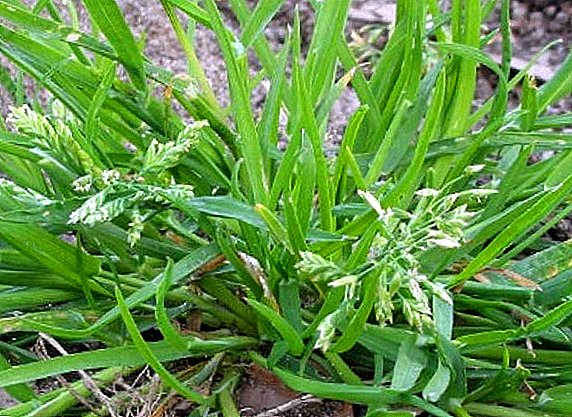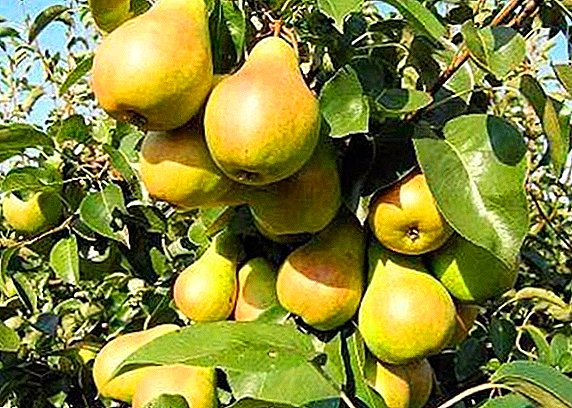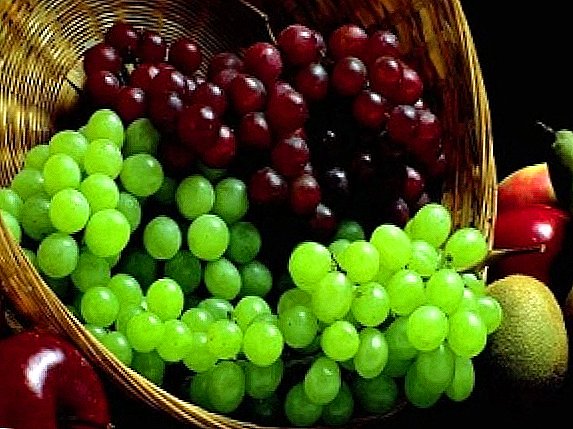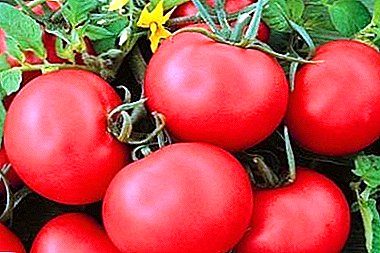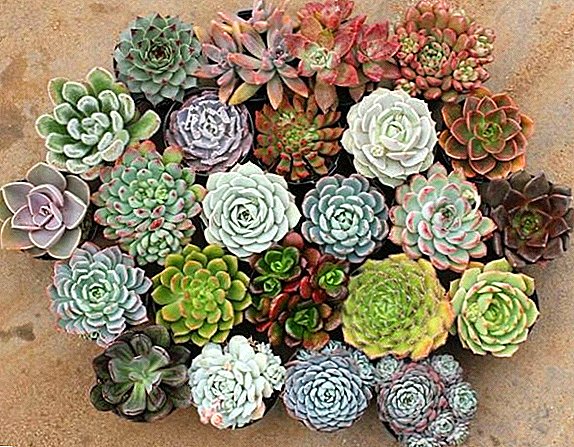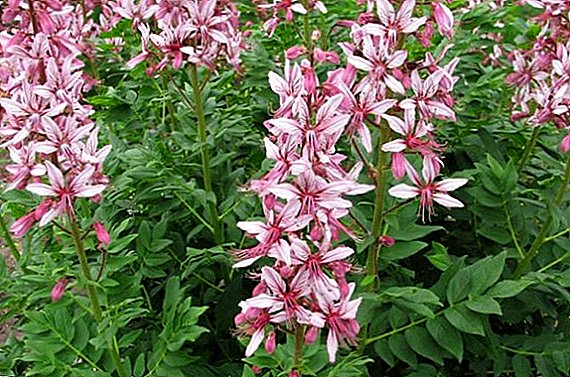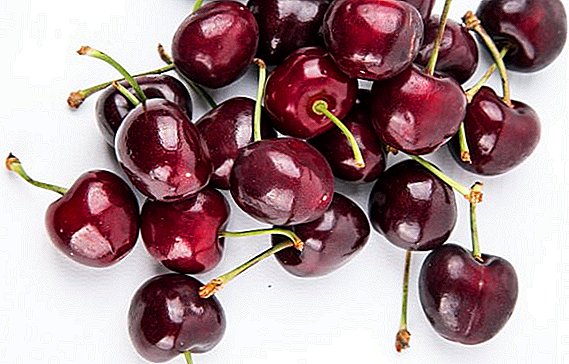 Cherry is a subgenus of plants of the genus Plum from the family Pink. At present, breeders have deduced hybrids of cherries and cherries, which are characterized by resistance to frost and diseases, as well as large sizes of fruits. The largest variety of cherries is Miracle Cherry.
Cherry is a subgenus of plants of the genus Plum from the family Pink. At present, breeders have deduced hybrids of cherries and cherries, which are characterized by resistance to frost and diseases, as well as large sizes of fruits. The largest variety of cherries is Miracle Cherry.
Did you know? The first cherries from Asia Minor to Rome were introduced by the commander and slave owner Lucull.
A meeting
Ukrainian variety obtained as a result of the crossing of Kiev-19 and Lyubskaya varieties, a hybrid of cherry and sweet cherry. The founders of the variety are N.I. Turovtsev and V.A. Turovtseva. This cherry has a fairly large fruit, which is the hallmark of the variety.  Low-growing tree about 2 m high, with dense spherical crown and drooping branches. Cherry fruits A large-sized, flat-rounded, dark-red berries weighing about 15 g meet with a thin, iridescent peel, rather easily removed, and tender fragrant flesh, with a sour-sweet taste and medium bone.
Low-growing tree about 2 m high, with dense spherical crown and drooping branches. Cherry fruits A large-sized, flat-rounded, dark-red berries weighing about 15 g meet with a thin, iridescent peel, rather easily removed, and tender fragrant flesh, with a sour-sweet taste and medium bone.
Berries ripen at the end of June, appear on the bouquet branches. Fruiting of grafted trees occurs 3-4 years after planting. In size of fruits, this variety exceeds only the large black cherry variety.
Cherry variety. The meeting is partially self-propelled, pollinators are Minx, Samsonovka. Up to 25 kg of berries can be harvested from an adult tree.
Important! The cherry fruit contains organic acids, trace elements and macronutrients and pectin substances.The variety is characterized by frost and drought tolerance, can withstand up to -25 ° C. There is no risk of contracting moniliasis and coccomycosis. Cherry Encounter is very popular among gardeners for the high quality of berries, resistance to fungal diseases, good transport ability.
The plant prefers loamy or sandy loosened soil, which contributes to the good development of the tree. Cherry is light-requiring, so you need to choose well-drained and lighted areas.
After planting, the ground sets, so the root of the neck should be slightly above the level of the soil. It is necessary to make a recess around the seedling in order to prevent the water from spreading beyond the boundaries of the tree circle. After planting requires abundant watering for 3-5 days, mulch the soil with peat or humus.
A toy
One of the varieties of large cherries. The vigorous variety, the tree reaches a height of 7 meters, the crown is oval and spherical, widely spreading.  The bark is gray on the trunk and skeletal branches and flakes a little. The plant has dark brown shoots, dense and even, dark green large, egg-shaped leaves, white self-infertile flowers appearing on a one-year growth, gathered into inflorescences of 4 pieces each, fruits are fairly large purple-tinted berries with a thin skin, a smooth surface and bone, which is easily separated.
The bark is gray on the trunk and skeletal branches and flakes a little. The plant has dark brown shoots, dense and even, dark green large, egg-shaped leaves, white self-infertile flowers appearing on a one-year growth, gathered into inflorescences of 4 pieces each, fruits are fairly large purple-tinted berries with a thin skin, a smooth surface and bone, which is easily separated.
Juicy cherry flesh The toy is rich red in color, and the sweet and sour taste is caused by low sugar content. The grafted seedling begins to bear fruit in the third year. The yield of the variety is high, on average 45-50 kg.
The variety is winter-hardy and drought-resistant, but the buds and flowers are quite vulnerable to cold. Resistance to fungal diseases is high. The best pollinators are the Wonder Cherry and Samsonovka varieties or the cherry varieties Valery Chkalov.
Did you know? Cherry came to Russia through Byzantium as early as the 13th century. One of the most common varieties - Vladimirskaya still remains the parent form for the hybrids created.For the proper development of cherry Toy is necessary observe the following agricultural techniques. Landing place - on an elevation, with enough sunlight and good airflow. When selecting productive varieties, attention should be paid to the ability to rooting well.
Is required correctly form the crown, not forgetting that the fruiting toy variety occurs on the annual shoots. This culture requires medium loamy light soils located far from the aquifer. Oxidized soils with liming.
For the formation and thinning of the crown, as well as to remove the affected branches is pruned. Protect the trunk from sunburn You can, whitewash it or wrap it in white paper.
At the beginning of winter make root dressing composted layer up to 10 cm and treated with peat. Cherry Toy does not need abundant watering, on average for one season up to 9 buckets are poured under each tree during flowering, ripening of the ovary, at the end of the harvest, when preparing for the winter.
Normal air exchange stalk land contributes to loosening and pierce with forks. As a preventive measure against pests, the plant is treated with insecticides, and to protect against rodents, they tie the trunk with barbed wire.
Sister
Obtained by crossing the cherry with cherry. Large berries weighing up to 8 g of an attractive heart-shaped form and practically do not crack. The vigorous trees begin to bear fruit in the fifth year, each year the harvest is about 50 kg.  Cherry variety Sister is very frost-resistant, can withstand temperatures up to -30 ° C. Also, cherries are not at risk for coccomycosis, it is easy to transport, the berries are stored at room temperature at about + 20-22 ° C for 2-3 weeks, and in the refrigerator for more than a month.
Cherry variety Sister is very frost-resistant, can withstand temperatures up to -30 ° C. Also, cherries are not at risk for coccomycosis, it is easy to transport, the berries are stored at room temperature at about + 20-22 ° C for 2-3 weeks, and in the refrigerator for more than a month.
Fruit ripening occurs in late June - early July. The best pollinators for the Sister variety will be Donchanka, Drogana yellow, Valeria, Annushka, Aelita.
Night
The Nochka variety was bred at the Donetsk Experimental Station of Horticulture by the breeder L. I. Taranenko using the method of targeted free pollination of Nord Star cherries and Valerian Chkalov cherry varieties.  Cherry Nochka has the following variety description: has high winter resistance and disease resistance. Ripens at the end of June, the berries are large, dark red, with purple flesh and delicate sweet taste, weighing up to 7 g, broadly heart-shaped, squeezed on the sides. The advantage of the variety is its high yield - up to 70 kg.
Cherry Nochka has the following variety description: has high winter resistance and disease resistance. Ripens at the end of June, the berries are large, dark red, with purple flesh and delicate sweet taste, weighing up to 7 g, broadly heart-shaped, squeezed on the sides. The advantage of the variety is its high yield - up to 70 kg.
Important! In the bones of cherries contain fatty oil, essential oil and glycoside amygdalin, in the bark - tannins and coumarin.
Black large
The variety was bred at the Rossoshansky zonal experimental gardening station of A. Ya. Voronchikhina as a result of crossing the varieties Zhukovskaya and Consumer black.
The tree is characterized by medium or weak force, does not exceed 3-4 m in height, the crown is broad-pyramidal or oval. On the trunk, the bark is gray-black, in young trees it has a dark gray color, with convex lentils.  This cherry variety has direct shoots, long internodes, initially brown-green, acquiring a silver plaque with age; leaf plate of elongated oval shape, on top of a dark green color, bottom - grayish green; petioles up to 2 cm long, rather dense, large, wide-cube-shaped flowers of a cream shade, often three flowers in inflorescence.
This cherry variety has direct shoots, long internodes, initially brown-green, acquiring a silver plaque with age; leaf plate of elongated oval shape, on top of a dark green color, bottom - grayish green; petioles up to 2 cm long, rather dense, large, wide-cube-shaped flowers of a cream shade, often three flowers in inflorescence.
Fruits of large size, weighing about 6 g, the shade of the skin is almost black, the flesh is dark cherry in color, with white veins, soft, the taste is pleasantly sweet and sour. Cherry Black is a large, self-productive fruit, in the description of the variety it is said that the good pollinators for it are the varieties Kent and Griot Ostgeymsky.
The berries ripen in early July, the fruiting of trees begins in the third year after planting, the yield is quite high - up to 30 kg. The shortcomings of the variety can be attributed to its fragility and susceptibility to coccomycosis and moniliosis, if it was rainy during flowering, to its merits - frost resistance to -32 ... -34 ° and high precocity.
Podbelskaya
The variety was bred by Koch in the 90s of the XIX century in Germany by crossing the variety Griot Ostheims and Lotovaya.
This vigorous tree, reaching a height of more than 5 m, forming a rounded, with time flat-rounded leafy crown. In Cherry Podbelskoy shoots - growing up, the leaves - large and emerald green, matte. The flowers of the Podbelskaya cherry are large, saucer-shaped, forming 4 each in inflorescence, with round corrugated petals.  The fruits are large, dark red, almost black, with scarlet fibrous pulp, harmonious pleasant taste and intense red juice and medium-sized bones. Fruiting grafted plants begins in the fourth year after planting, the increase in yield is slow. Early-medium maturation in mid-June.
The fruits are large, dark red, almost black, with scarlet fibrous pulp, harmonious pleasant taste and intense red juice and medium-sized bones. Fruiting grafted plants begins in the fourth year after planting, the increase in yield is slow. Early-medium maturation in mid-June.
Since the variety is self-infertile, the best early pollinators will be English Early, Anadol. The productivity of the variety is on average 50-70 kg. The variety does not differ in winter hardiness, in the winter generative buds often freeze out, in the spring flowers and buds suffer.
Resistance to fungal diseases and heat resistance - medium. The southern regions with mild winters are suitable for this variety, in colder climates it will suffer from burns and freezing. By its nature, the variety is pentaploid with excellent taste qualities of dessert and technical purposes. Cherry large sweet, this is the main feature of the variety.
Miracle cherry
Variety Miracle Cherry has a large fruit size (up to 10 g), which is 1.5 times more than any average sweet cherry, and high palatability. The berries are dark red, with soft, tender and easily separated peel, looks very much like a sweet cherry, the taste is sweet and sour-sweet.  Cherry Miracle Cherry has the following description: It has a high disease resistance, tolerates drought, heat and low temperatures. During flowering, Mirage, Raisin, Totem and Epic are best pollinated with cherries. But it should not be used as pollinators of the variety Drogana yellow, Farewell and Valery Chkalov.
Cherry Miracle Cherry has the following description: It has a high disease resistance, tolerates drought, heat and low temperatures. During flowering, Mirage, Raisin, Totem and Epic are best pollinated with cherries. But it should not be used as pollinators of the variety Drogana yellow, Farewell and Valery Chkalov.
Dessert Morozova
Bred from the seed of the Vladimirskaya cherry variety. V. Morozova. Medium-growth tree with a wide-round spreading medium leafy crown. Fruits mainly on annual growths.  The variety Dessert Morozova has large gray-green shoots, ovate, rejected bud, medium length of leaf petioles, light green leaves, pink-like white flowers, large red rounded berries weighing about 5 g with a long stalk and an average bone, soft dense flesh and dessert sweet taste, ripening in the second decade of June.
The variety Dessert Morozova has large gray-green shoots, ovate, rejected bud, medium length of leaf petioles, light green leaves, pink-like white flowers, large red rounded berries weighing about 5 g with a long stalk and an average bone, soft dense flesh and dessert sweet taste, ripening in the second decade of June.
A characteristic feature of this sort of cherry is the fruiting of large fruits. It begins to bear fruit in the third year, the yield is about 50 c / ha. The variety is partially self-fertile, best pollinated by Griot Ostheim, Vladimir, Student. Propagated by green cuttings. Pruning involves shortening bare branches. The variety is winter-hardy, moderately drought-resistant, not at risk of getting coccomycosis.
Windmills
Obtained as a result of free pollination of the variety Novodvorskaya by breeders Syubarova and Sulimova. In state trials since 2004  Powerful tree with medium pyramidal crown. Wyanok varieties are characterized by medium-sized maroon, rounded berries (up to 4 g) with an average bone, juicy thick dark red flesh and a sweet and sour dessert.
Powerful tree with medium pyramidal crown. Wyanok varieties are characterized by medium-sized maroon, rounded berries (up to 4 g) with an average bone, juicy thick dark red flesh and a sweet and sour dessert.
Enters fructification in the third year after planting, the fruits ripen in late June. The variety Vianok is self-fertile, high-yielding (13 t / ha), frost-resistant, shows moderate resistance to coccomycosis and moniliosis.
Minx
Bred Breeders Turovtsev at the Institute of Irrigated Horticulture them. M. Sidorenko by crossing varieties Samsonovka and Kievskaya-19.
The Shalunya tree is medium-sized, with a sprawling dense crown, a gray-brown bark peeling on the trunk, dense straight shoots with numerous gray lentils. Cherry leaves are medium in size, obovate, bright green in color, with a shiny surface and short petiole. Fruiting - on bouquet branches and one-year growth.  Cranberries Berry is dark red, almost black, with subtle dermal spots and dense skin that can be easily removed, large, one-dimensional, weighing up to 6 g and a stem about 43 mm. The flesh is burgundy, the taste of cherries is sweet and refreshing, the bone is small and free. Fruits ripen at a high temperature on the 20th of June.
Cranberries Berry is dark red, almost black, with subtle dermal spots and dense skin that can be easily removed, large, one-dimensional, weighing up to 6 g and a stem about 43 mm. The flesh is burgundy, the taste of cherries is sweet and refreshing, the bone is small and free. Fruits ripen at a high temperature on the 20th of June.
The Minx Cherry is a self-fertile, pollinating its varieties Chernokorka, Samsonovka, Vinka. Fruiting begins 3 years after planting. The average yield is 40 kg per tree. The variety is valuable for its resistance to fungal diseases, drought and low temperatures (can withstand up to -25 ° C).


